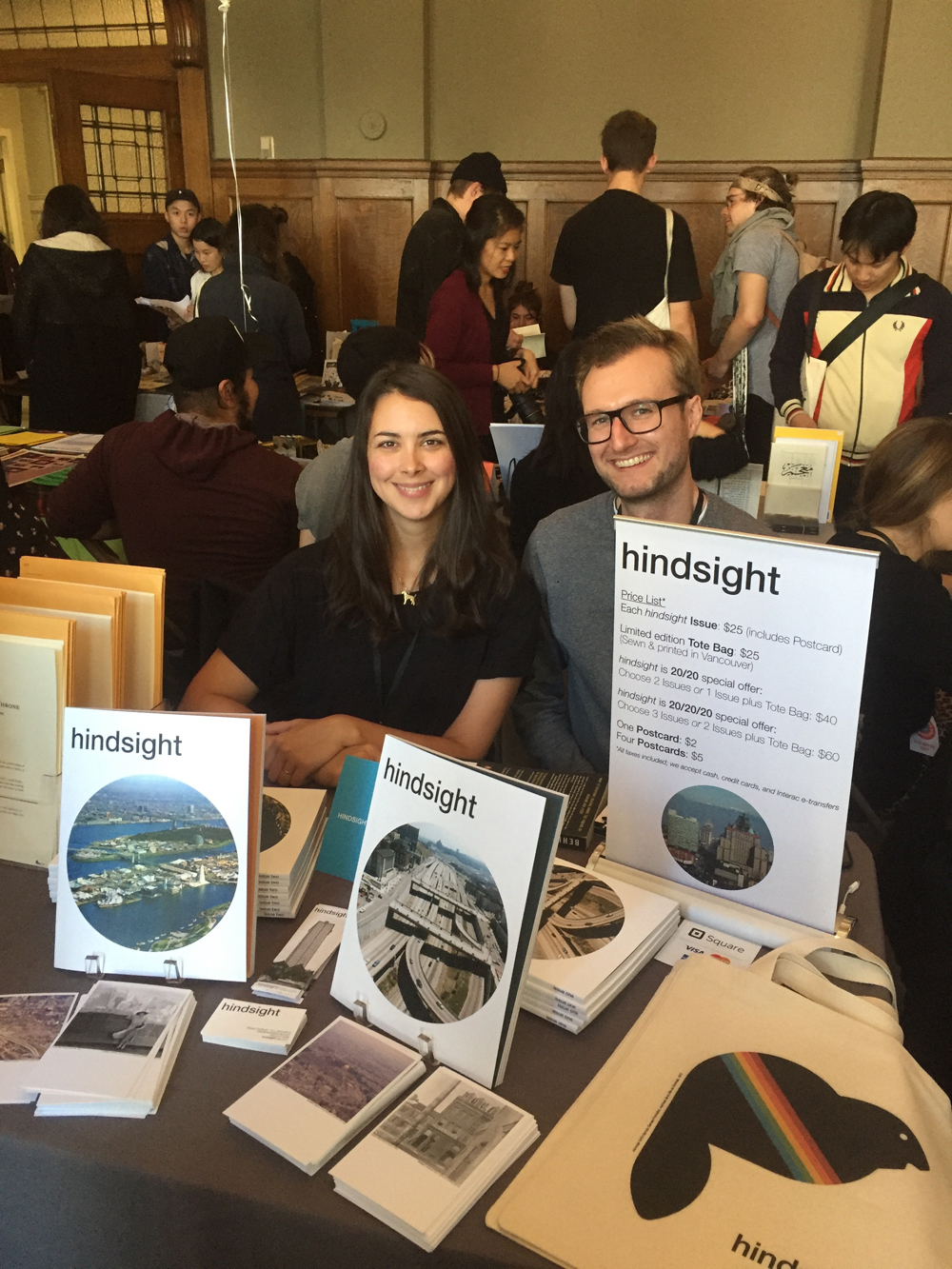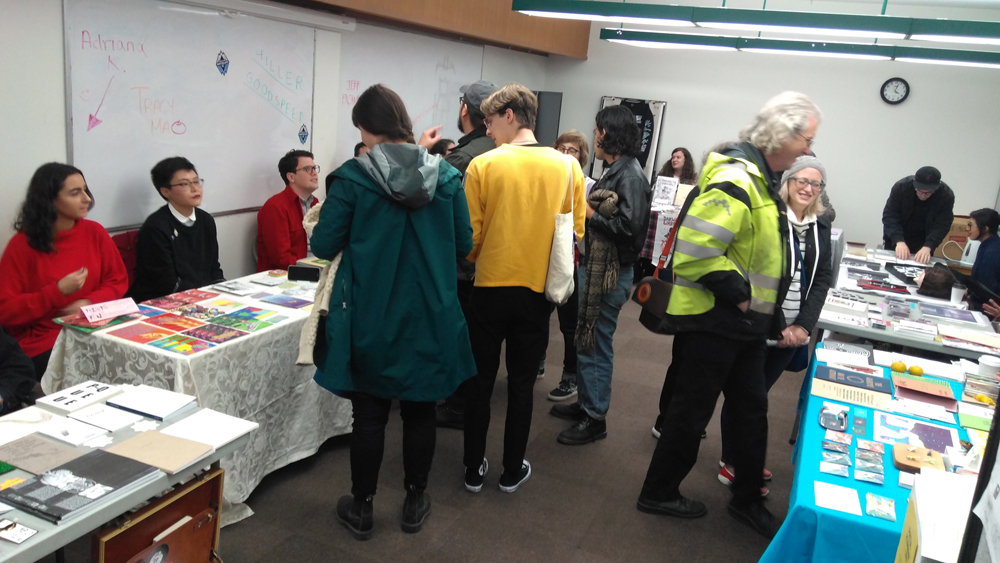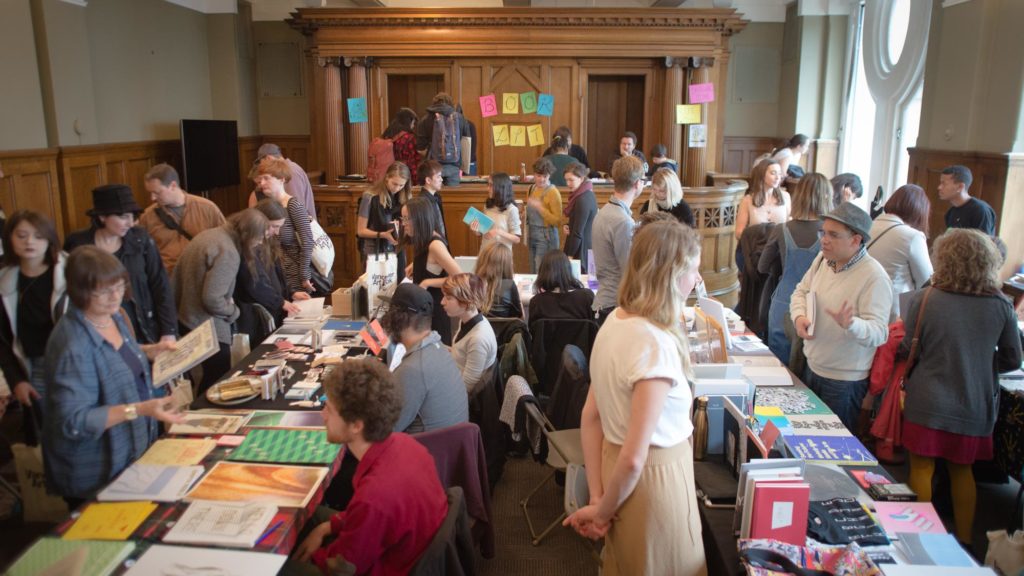This year’s Vancouver Art Book Fair (VABF), the sixth ever, was as humid and socially uneasy as the city’s best parties. For one weekend every fall, the VABF is the nucleus for much of Vancouver’s art scene. The annual event makes use of the rarely utilized back rooms and un-renovated corners of the Vancouver Art Gallery. Appropriate, as the crowd is often a symbolic unearthing of attendees’ half-forgotten personal histories. Ex-lovers, acrimonious roommates, former bosses: for a certain segment of Vancouver’s populace, run-ins are the order of the day, every day of the VABF.
Are we here for the books? Yes and no. The function of a book fair has always been social as well as commercial. Vendors use the opportunity to both network and promote their wares. This double agenda extends to visitors, who are often there as much to browse and buy as they are to scope out the scene, or in many cases, the competition (after all, who doesn’t feel like they have at least one zine in them?). Aware of this dual function, the VABF schedules programming, talks, readings and parties aimed at book-adjacent aspects of the fair.
Friday night was a members-only preview, followed by an official afterparty inside the Fox, a Main Street spot that was once an adult movie theater. The place features the nesting-doll setup of many Vancouver venues (a smaller, slightly cooler space inside a larger one); in this case, the Projection Room, a bar above the other bar, in reputation and spatial relation, is where the VABF afterparty actually happened.
The space of the Projection Room put me in mind of the VABF itself, which in many ways perpetuates this Vancouver tradition of hidden-ish venues. This is too small a city for the stratum of one scene not to trip over each other; a situation encapsulated by the VABF, where a person can sell zines in the same building that houses a major Emily Carr collection.
The VABF has stature locally, but speaking to many of the exhibitors on Saturday morning convinced me of its wider importance. Two separate tables, belonging to the Toronto Art Book Fair and Dubai’s Fully Booked Art Book Fair, spoke of VABF founder Tracy Stefanucci as a mentoring presence in the creation of their own fairs. Many exhibitors, if not visiting from another country, had exhibited at art book fairs internationally.
Daphne Taranto of Dubai’s Fully Booked Art Book Fair described the VABF as “less rabid” than others, quite a statement considering her table was picked clean by midday on Saturday. Other notables included Mitsu Okubo from San Francisco’s Basement, visiting Canada for the first time, who came to us with the coveted “*SIGH* Twombly” tee shirt. Björn Engberg of Sweden’s Moon Space Books delivered two presentations as well as exhibited a table of artful photobooks, including an exquisite visual travelogue called Bear Field Mountains.
On the marble staircase that connected the exhibition rooms, I met an acquaintance; a young man with Vancouver’s most successful septum piercing. He declared the venue “really hot,” temperature-wise, and asked me to put my number in his flip phone. How do you put your number in a flip phone? Neither of us knew, but the joy of anachronistic technology was a theme that ran through much of the fair.
Some of the best tables featured forgotten media: Luca Antonucci of Colpa Press had for sale a trio of neon volumes, each filled with vintage rave flyers from a different American city. Also at this table, a VHS tape. The table shared by Vancouver artists Hei Lam Ng and Carli Boisjolie featured a zine vending machine.
A deservedly popular table belonged to Hindsight magazine, the project of Vancouver-based urban planners Megan Faulkner and R.J. McCulloch. Hindsight uses archival photography to explore matters related to urban design: each issue a different issue. The archival photos of different cities, slightly grainy and definitely lush, have the uncanny aspect of making the global cities featured look almost the same. The singular focus and depth of research in Hindsight was exciting, and a through-line of the best work at the fair.
 Megan Faulkner and R.J. McCulloch of Hindsight magazine. Founded by these two urban planners, Hindsight focuses on archival photos of urban design. Photo: Meredyth Cole.
Megan Faulkner and R.J. McCulloch of Hindsight magazine. Founded by these two urban planners, Hindsight focuses on archival photos of urban design. Photo: Meredyth Cole.
Rental prices, as we know, are a fraught subject in Vancouver, and the cost of real-estate inside the VABF was an unavoidable issue. A concurrent event popped up in Mount Pleasant, called B00K: an alternative press expo, which some referred to as a “rival fair,” and others an “alternative fair,” and others still, just “another fair.”
One thing is for sure, it was a cheaper fair; exhibitors could rent a table for 10 dollars, as opposed to a fee of more than 10 times that at the VABF. (Rates vary at the VABF by table size, wall availability and location, but they start at 100 dollars and go upward from there.) I met a few exhibitors making use of both venues and when I visited B00K late on Saturday, it felt more like a younger, un-official annex of the VABF than a challenger of it.
 The smaller-scale B00k alternative press expo popped up in Mount Pleasant concurrently with the Vancouver Art Book Fair. Photo: Tom Whalen.
The smaller-scale B00k alternative press expo popped up in Mount Pleasant concurrently with the Vancouver Art Book Fair. Photo: Tom Whalen.
On the third-floor hallway of the Vancouver Art Gallery, I found a table, tucked away on a semi-circular stage, with the fair’s worst location, and its best concept. The area, when I visited, was manned by Natasha Lands, a member of the VABF board of directors, who was operating it on behalf of a collective called Free Association, and offered multiples from various artists and sources. Here, I bought As.iZ magazine, a publication with a touchable aesthetic and Vancouver connections. I also considered a pair of dollar-store sunglasses with Virgil Abloh’s forged signature written on the arms in white sharpie. They were delightful, but hurt my temples.
As is usual, the VABF was crowded; Fjällräven backpacks bumped against each other like punts on a river. The lectures, held in a library on the second floor, were less packed and offered some relief. I caught a talk by Quebec-based duo ARCHITECTURAMA, made up of Sylvain Bilodeau and Nicolas Mathieu-Tremblay, who reflected on the parallels between publishing and architecture, notably in the concept of “paper architecture,” projects that are never actualized and exist only as plans.
In book fairs, as in life, it is the missed opportunities that linger in your mind. I failed to purchase probably the best thing at the VABF, a photobook called You Get Me?, filled with tense, vital portraits by British artist Mahtab Hussain. The book focuses on Asian working-class men living in Britain and surveys self-presentation within this community; it is the result of nine years of work.
I also took the art book fair too literally, neglecting to buy any of the prints or other art objects for sale. Alicia Nauta of Toronto had a table full of prints I regret walking away from; her work evoked both black-light posters and the arch, deliberately lo-fi event flyers I associate with parties in this city.
By Sunday, I was such a lingering presence that even the most effusive volunteer greeters no longer offered me free tote bags. Day three had a decidedly hungover cast, no less busy, but a hint laxer than before. In the foyer of the gallery, I saw a sandwich laying on the floor—accident, or deliberate disruption? Upstairs, I spoke with a young man wearing a stolen “exhibitors” lanyard. “The cool people find each other here,” he told me, dangling a VHS camera from one hand.
What did he mean by cool? That’s another article, but there was a notable split between the glossy art books and the more DIY efforts, a breadth that I found comprehensive, but that others clearly found annoying. Another thing that irked many: the Vancouver Art Gallery selling discards from their library collection in the foyer for two to five dollars apiece, while upstairs, artists hustled fifty-dollar monographs.
This foyer is where I sat on Sunday afternoon, underfed and overclothed. All weekend, people dressed for rain but found only sunshine. The steps of the VAG annex clattered, like a high school hallway between periods. I accepted oversaturation.
I’d been here for the better part of three days, and lived in this city, where art and publishing seem exceptionally interconnected, for the better part of four years. The VABF was Canada’s first international art book fair (it won’t be the last), but even as it is replicated (and even though the concept is itself a replica), its Vancouver-ness is irreducible. It is not just the people you see (and there is no one I didn’t see), but the spirit and scale of the event.
The next day, things became slightly more diffuse again: social scenes and the city’s atmosphere. It rained.
Meredyth Cole is a writer based in Vancouver and London.

 Saturday at the Vancouver Art Book Fair. Photo: Bryce Hunnersen of Vandocument via VABF Facebook page.
Saturday at the Vancouver Art Book Fair. Photo: Bryce Hunnersen of Vandocument via VABF Facebook page.







